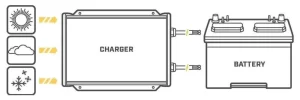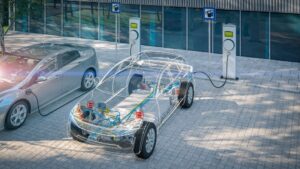If you want to improve the efficiency and convenience of your electric vehicle, one way to do that is to optimize your EVF traction battery charging infrastructure. As the demand for electric cars grows exponentially, we must ensure a robust yet streamlined charging infrastructure. In this comprehensive guide, we deeply dive into methods and best practices for optimizing EVF traction battery charging infrastructure, providing insights to maximize users’ experience.
Learn EVF Traction Battery Charging Basics
EVF traction battery charging involves providing electrical energy to replenish stored electricity. There are two main charging methods: AC (alternating current) and DC (direct current). AC charging is typical in residential and commercial settings, utilizing standard electrical outlets or dedicated charging stations. On the other hand, DC fast charging allows for rapid charging at dedicated charging stations, significantly shortening charging time.
Charge levels are classified based on the amount of power provided to the battery. Level 1 involves standard household outlets and provides slower charging rates for overnight charging. Level 2 utilizes higher voltage charging stations to provide faster charging rates and is ideal for home installations and public charging points. The last level is DC Fast Charging, which provides the fastest charging option and is suitable for mobile charging and long-distance travel.
Charging infrastructure, including charging stations and connectors, is critical to adopting electric vehicles. Standardizing charging connectors like CCS or CHAdeMO ensures interoperability between vehicle models and charging stations.

Charging infrastructure optimization strategy
Place charging stations in high-traffic areas, primarily on transport routes and major city centers. Establishing powerful, fast charging stations and high-power Level 3 DC fast chargers along highways and in urban areas will enable fast charging and reduce the time required to charge batteries. In addition, standardized charging connectors such as CCS and CHAdeMO can also be used to ensure interoperability between different models and charging stations. This brings a seamless charging experience to electric vehicle users.
Advanced EVF traction battery technology improves the charging experience
By integrating innovative charging solutions into the charging infrastructure. Technologies such as smart grids, demand response systems, and dynamic pricing can help make EVF traction battery charging more efficient. Implementing these solutions will enable users to set during periods of lower power demand, thereby reducing costs and promoting grid stability. Smart charging functions are integrated into the electric vehicle management system, allowing users to optimize charging schedules based on their preferences and energy cost considerations. Our EV power batteries have high energy density and can store more energy in a smaller, lighter package. This allows for greater distances on a single charge, reducing charging frequency and enhancing the overall charging experience.

User-centered optimized charging strategy
We can design charging stations with user-friendly interfaces and clear instructions to enhance the user charging experience. Intuitive displays, simple payment methods, and simple plug-in mechanisms contribute to positive user interaction. By providing flexible charging options, such as adjustable charging speed, peak-shifting charging, etc., we can meet the needs of different users. This flexibility allows users to choose based on cost, time, and energy efficiency. We also implement a user-centric predictive charging algorithm that considers user habits, travel patterns, and preferences to optimize charging schedules. This ensures the vehicle is charged when needed, fitting the user’s daily routine and minimizing waiting times.
Wireless charging technology
Wireless charging technology for charging EVF traction batteries represents a cutting-edge advancement in the EV industry. This technology eliminates the need for physical charging cables, providing a more convenient and efficient charging experience. Wireless charging pads can be integrated into various surfaces, such as parking spaces, roads, or garage floors. This integration enables seamless automatic charging when an electric vehicle is parked in a designated charging area, improving user convenience. Wireless charging pads can be integrated into various surfaces, such as parking spaces, roads, or garage floors. This integration enables seamless automatic charging when an electric vehicle is parked in a designated charging area, improving user convenience.
Final
If you want to optimize EVF traction, battery charging infrastructure is a multi-faceted, dynamic endeavor. Improve your charging equipment by thoroughly understanding charging basics and infrastructure and using advanced technologies. If you want your EVF traction battery to have a longer life, you must not ignore this aspect of work.

